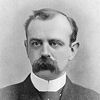
John Honey (1781–1813) became famous as a nineteen-year-old student of the University of St Andrews. On 5 January 1800 he was attending a service at St Salvator's Chapel when the congregation received news that a small ship, the Janet of Macduff, had run aground east of the town harbour. Five men were stranded in the sea and, at the time, there was no lifeboat stationed in the town. A crowd had gathered, but the sea was stormy and rescue attempts failed. [1]

The University of St Andrews is a British public university in St Andrews, Fife, Scotland. It is the oldest of the four ancient universities of Scotland and the third oldest university in the English-speaking world. St Andrews was founded between 1410 and 1413, when the Avignon Antipope Benedict XIII issued a papal bull to a small founding group of Augustinian clergy.

St Salvator's Chapel is one of two collegiate chapels belonging to the University of St Andrews, the other being St Leonard's Chapel. It was founded in 1450, by Bishop James Kennedy, built in the Late Gothic architectural style, and refurbished in the 1680s, 1860s and throughout the 20th century. It is currently the chapel of the United college as well as being the major university chapel.
A rescue lifeboat is a boat rescue craft which is used to attend a vessel in distress, or its survivors, to rescue crew and passengers. It can be hand pulled, sail powered or powered by an engine. Lifeboats may be rigid, inflatable or rigid-inflatable combination hulled vessels.
Contents
However, Honey, apparently determined not to let the men drown without attempting a rescue, stripped off his clothes, had fellow students tie a rope around him, took a knife, and entered the water. After a false start when his friends thought he would be unable to reach the men and pulled him back ashore, Honey struck out once more, reached and boarded the sinking boat and brought from it a rope back to the shore, to serve as a lifeline to allow the men to escape. However, the crew were too weary to make the journey to shore alone, so Honey made five more trips to and from the boat, taking each man to safety in turn, before collapsing of exhaustion on the shore. [2]
Honey is commonly misunderstood to have died during the rescue attempt. In fact he survived to receive the Freedom of the Cities of St Andrews, Perth, Forfar and Auchtermuchty. His commendation from the magistrates of St Andrews reads: "[This] is the only gift that this corporation can bestow upon you, for your wonderful and unexampled exertions in rescuing from the jaws of death the master and four seamen of the sloop the Janet of Macduff, wrecked in these sands of St Andrews, and who, but for your humane and unparalleled exertions, at the imminent hazard of your own life, must have inevitably perished." [3] He went on to become a Perthshire minister, but died at the age of 32 following a prolonged period of ill-health thought to have been linked to injuries he sustained on his final trip, when struck across the chest by a falling mast.

The Freedom of the City is an honour bestowed by a municipality upon a valued member of the community, or upon a visiting celebrity or dignitary. Arising from the medieval practice of granting respected citizens freedom from serfdom, the tradition still lives on in countries such as the United Kingdom, Ireland, Australia, Canada, South Africa and New Zealand – although today the title of "freeman" confers no special privileges. The Freedom of the City can also be granted by municipal authorities to military units which have earned the city's trust; in this context, it is sometimes called the Freedom of Entry. This allows them the freedom to parade through the city, and is an affirmation of the bond between the regiment and the citizenry.

St Andrews is a town on the east coast of Fife in Scotland, 10 miles (16 km) southeast of Dundee and 30 miles (50 km) northeast of Edinburgh. St Andrews has a recorded population of 16,800 in 2011, making it Fife's fourth largest settlement and 45th most populous settlement in Scotland.

Perth is a city in central Scotland, on the banks of the River Tay. It is the administrative centre of Perth and Kinross council area and the historic county town of Perthshire. It has a population of about 47,180. Perth has been known as The Fair City since the publication of the story Fair Maid of Perth by Scottish writer Sir Walter Scott in 1828. During the later medieval period the city was also called St John's Toun or Saint Johnstoun by its inhabitants in reference to the main church dedicated to St John the Baptist. This name is preserved by the city's football teams, St Johnstone F.C.














